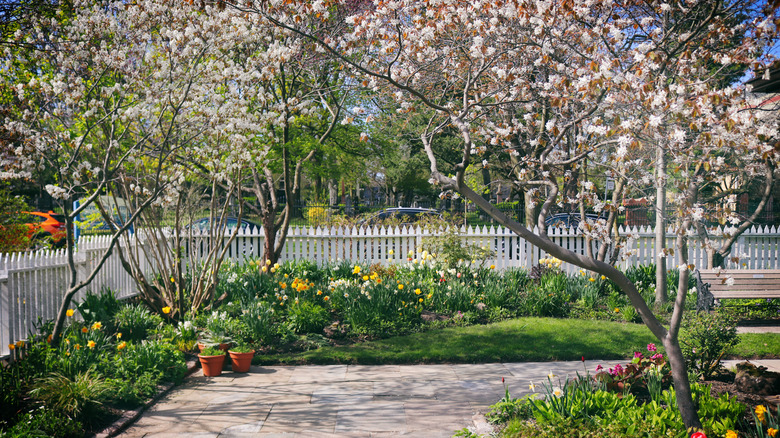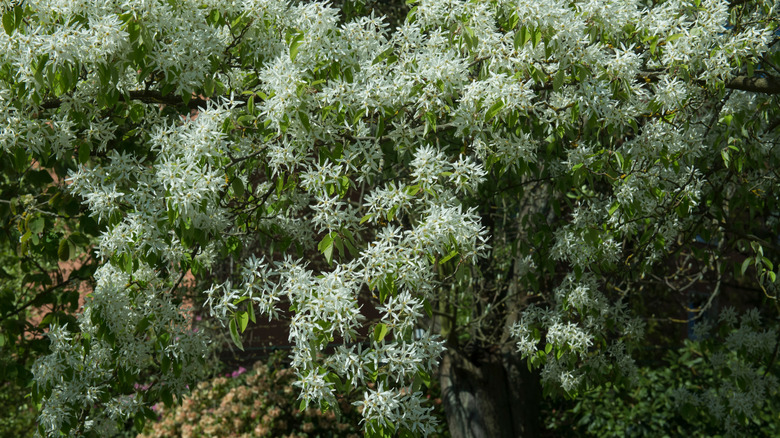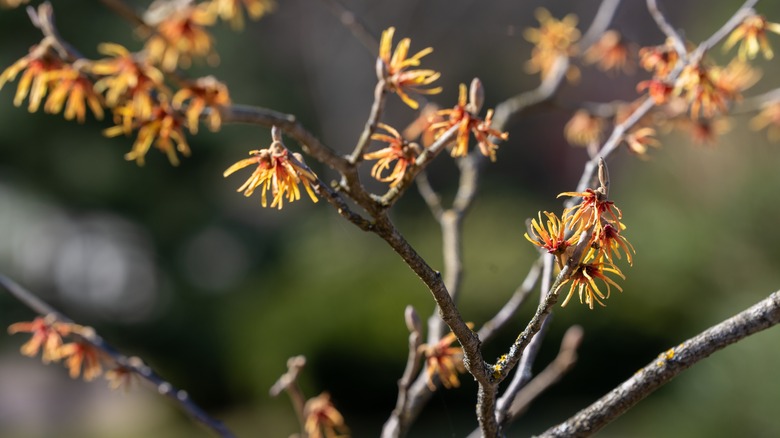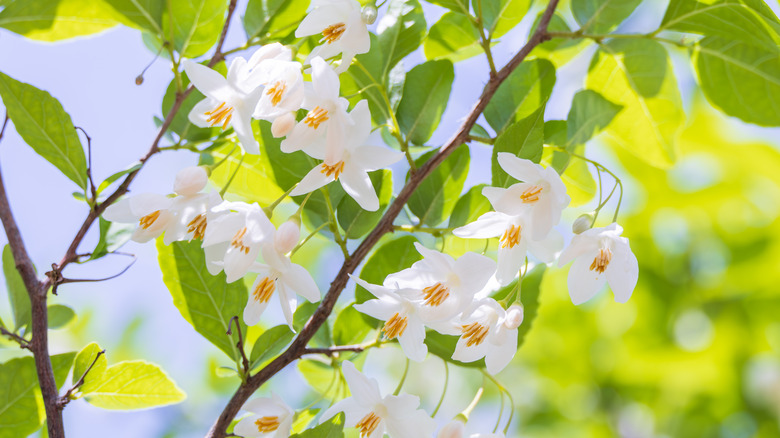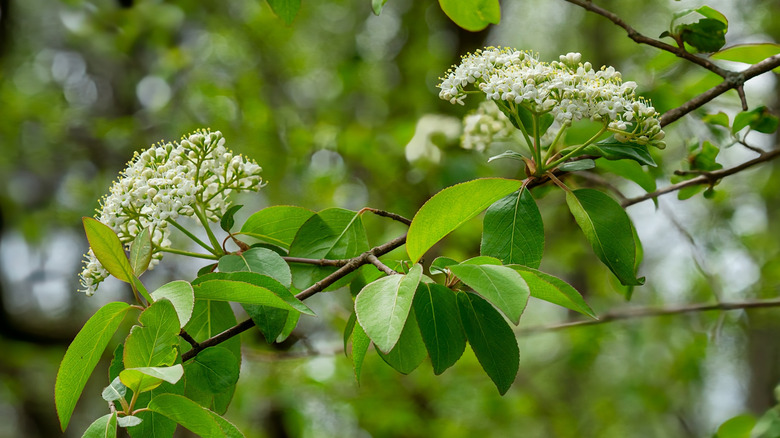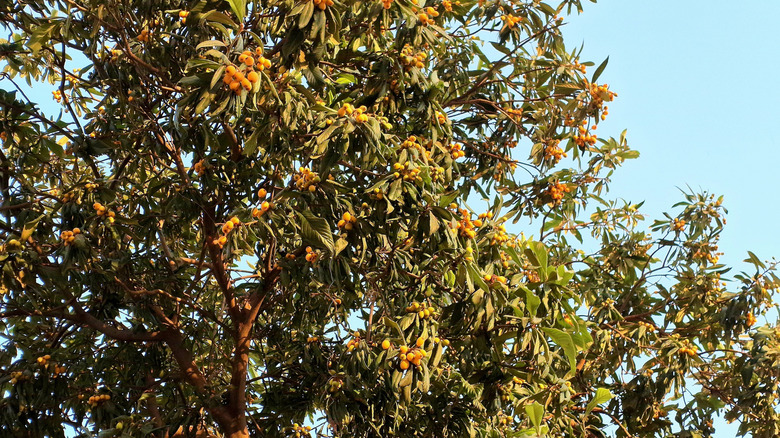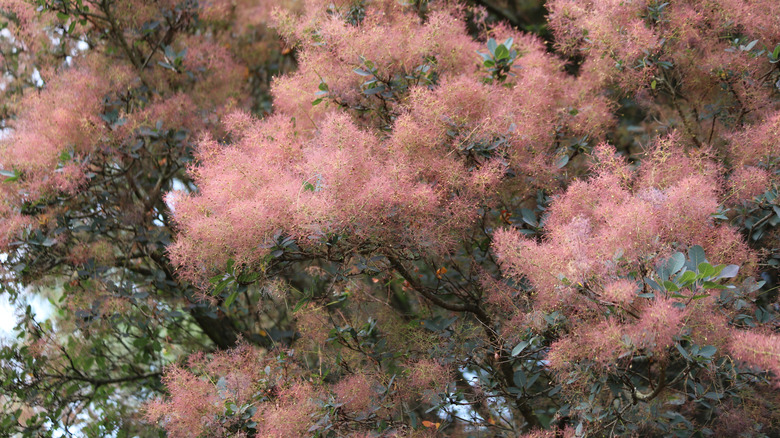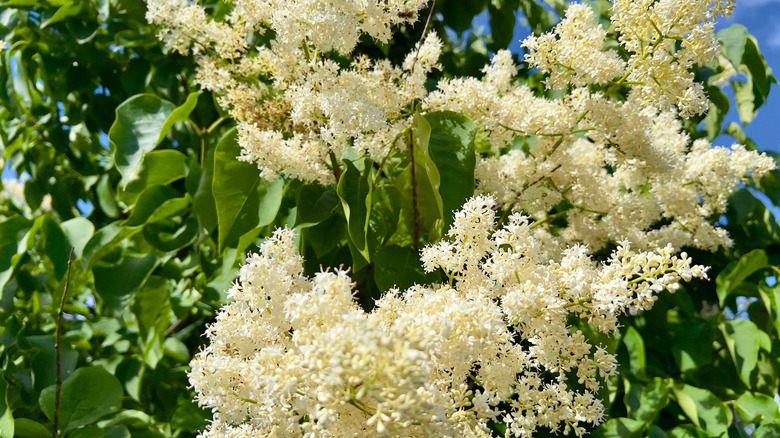8 Trees That Won't Take Over A Yard Or Garden And Thrive In The Sun
There are many ways to add variety to a garden that seems a little ... blah. You can try incorporating a wide range of different plant and flower colors and textures for a little extra pizzazz. But have you ever considered the height of your plant selections as a way to add visual interest? It might seem like a no-brainer to put the shortest plants at the front and the tallest at the back, but consider the many angles from which your garden can be viewed — you don't want to neglect the viewer looking out of an upstairs window, or the viewer glimpsing it from the street! This may leave you with some unanticipated awkward middling spots to fill — some blazing in full sun — and light-loving small trees that grow no higher than 14 to 25 feet might just be the ticket.
There are myriad options for compact trees that can work perfectly in the full-sun spaces that are still open in your yard, such as apple serviceberry, blackhaw, and Peking lilac. Just make sure to carefully consider the soil and climate conditions you have to accommodate, as well as the amount of maintenance you'd be comfortable performing. You can even consider mixing and matching different compatible species for a full, unique garden topography.
Apple serviceberry
A naturally occurring hybrid of two serviceberry species, apple serviceberry (Amelanchier x grandiflora) can be grown as either a small tree or shrub in USDA Hardiness Zones 3 through 8. It's considered a visual feast for all four seasons, bursting with white flowers in spring, attractive bluish leaves in summer, red foliage in fall, and the bare beauty of its silvery bark in winter. Its dark fruits, which visually resemble blueberries, are edible and sweet – useful for jams, pies, and other treats. It tends to prefer slightly acidic, loamy soil, and can tolerate some drought.
Ozark witch hazel
If you want a tough little shrubby tree that will weather the elements while still flowering beautifully, look no further than native Ozark witch hazel (Hamamelis vernalis). Although it will grow well in partial shade, it shines in full sun, flowering from late winter through early spring in ribbons of red and gold. Hardy in zones 4 through 8, Ozark witch hazel is unique since it flowers in the winter, adding a pop of color to otherwise dormant gardens. It tends to prefer moist, acidic soil — so provide water in hot, dry months to avoid leaf scorch.
Two-wing silverbell
Native to the southeastern United States, the elegant little two-wing silverbell or American snowdrop tree (Halesia diptera) can grow in full sun or part shade applications in zones 5 through 8. It thrives on the edges of swamps and floodplains, so its wild form isn't drought tolerant, But the commonly available 'Magniflora' cultivar boasts improved tolerance of dry conditions, and slightly larger, more plentiful flowers. Enjoy a show of pendulous white blossoms in spring, as well as the edible, two-winged fruit from which it takes one of its common names, which ripens in fall and winter.
Seven-son flower
A fragrant, attractive member of the honeysuckle tree family hailing from China, seven-son flower (Heptacodium miconioides) can be grown as a shrub or trained as a small tree. Its white flowers bloom fairly late in the season, from late summer to fall. When the petals drop, interior rose-pink sepals are revealed, delivering an encore performance. It provides visual interest in the fall and winter with its beautiful red-purple fruits and peeling bark. Suited to zones 5 through 9, seven-son flower isn't fussy about soil quality and can be grown in full sun or part shade.
Blackhaw
A U.S. native, blackhaw (Viburnum prunifolium) is a type of viburnum bush or tree and a favorite of pollinators, birds, and other wildlife thanks to its fragrant, nectar-rich white flowers and edible berries. In fall, its leaves turn red and purple, providing a splash of autumnal color for your yard. Ideal for urban applications in zones 3 through 9, this hardy little tree isn't picky about soil conditions and requires little maintenance. Just note that pruning should be done immediately after the flowering season so you aren't cutting off next year's buds.
Loquat
If you're in the market for a unique sun-loving fruit tree and you live in a warmer area with mild winters — generally zones 8 through 11 — a loquat tree (Eriobotrya japonica) might be the perfect choice. This evergreen tree's small, aromatic white flowers bloom in late fall and early winter, giving way to delicious (and nutritious!) edible fruit in late winter and early spring. Although the tree itself can tolerate fairly cold winters, note that below about 28 degrees Fahrenheit, it probably won't flower or set fruit. Native to China and Japan, loquats can tolerate some drought and salt.
Common smoketree
The common smoketree (Cotinus coggygria) takes its common name from the hairlike filaments that branch out from spent flowers, which turn a pinkish hue in summer and give the tree the appearance of a dreamy, smoky haze. Hardy in zones 4 through 8, the common smoketree is a full sun lover and is drought-resistant and tolerant of a wide range of soil types, including rocky, infertile soils. Several cultivars are available, featuring many leaf and flower colors. Note that direct skin contact with the sap may produce mild contact dermatitis, so consider wearing gloves when pruning.
Peking lilac
Drawing its name from the old name for Beijing, the Peking lilac (Syringa reticulata subsp. pekinensis), or Chinese tree lilac, is a great choice for full sun applications in zones 3 through 7. In mid-spring, Peking lilac bursts into bloom with clusters of sweet-smelling creamy flowers while its colorful exfoliating bark provides further visual interest. It's a fairly low-lift tree when grown in well-draining soil with adequate air circulation, and has some resistance to pests that tend to plague lilacs, such as powdery mildew. It does favor cooler summers and needs a period of cold weather to bloom.
